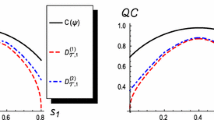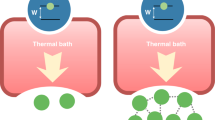Abstract
We prove that a finite correlation length, i.e., exponential decay of correlations, implies an area law for the entanglement entropy of quantum states defined on a line. The entropy bound is exponential in the correlation length of the state, thus reproducing as a particular case Hastings’s proof of an area law for groundstates of 1D gapped Hamiltonians.
As a consequence, we show that 1D quantum states with exponential decay of correlations have an efficient classical approximate description as a matrix product state of polynomial bond dimension, thus giving an equivalence between injective matrix product states and states with a finite correlation length.
The result can be seen as a rigorous justification, in one dimension, of the intuition that states with exponential decay of correlations, usually associated with non-critical phases of matter, are simple to describe. It also has implications for quantum computing: it shows that unless a pure state quantum computation involves states with long-range correlations, decaying at most algebraically with the distance, it can be efficiently simulated classically.
The proof relies on several previous tools from quantum information theory—including entanglement distillation protocols achieving the hashing bound, properties of single-shot smooth entropies, and the quantum substate theorem—and also on some newly developed ones. In particular we derive a new bound on correlations established by local random measurements, and we give a generalization to the max-entropy of a result of Hastings concerning the saturation of mutual information in multiparticle systems. The proof can also be interpreted as providing a limitation on the phenomenon of data hiding in quantum states.
Similar content being viewed by others
References
Araki H., Hepp K., Ruelle D.: Asymptotic behaviour of Wightman functions. Helv. Phys. Acta 35, 164 (1962)
Fredenhagen K.: A remark on the cluster theorem. Commun. Math. Phys. 97, 461 (1985)
Nachtergaele B., Sims R.: Lieb-Robinson bounds and the exponential clustering theorem. Commun. Math. Phys. 265, 119 (2006)
Hastings M.B.: Lieb-Schultz-Mattis in higher dimensions. Phys. Rev. B 69, 104431 (2004)
Hastings M.B.: Locality in quantum and markov dynamics on lattices and networks. Phys. Rev. Lett. 93, 140402 (2004)
M.B. Hastings: Decay of correlations in fermi systems at non-zero temperature. Phys. Rev. Lett. 93, 126402 (2004)
Hastings M.B., Koma T.: Spectral gap and exponential decay of correlations. Commun. Math. Phys. 265, 781 (2006)
Aharonov D., Arad I., Landau Z., Vazirani U.: The detectability lemma and its applications to quantum Hamiltonian complexity. New J. Phys. 13, 113043 (2011)
Horodecki R., Horodecki P., Horodecki M., Horodecki K.: Quantum entanglement. Rev. Mod. Phys. 81, 865 (2009)
Eisert J., Cramer M., Plenio M.B.: Colloquium: area laws for the entanglement entropy. Rev. Mod. Phys. 82, 277 (2010)
Bennett C.H., Bernstein H.J., Popescu S., Schumacher B.: Concentrating partial entanglement by local operations. Phys. Rev. A 53, 2046 (1996)
Bekenstein J.D.: Black holes and entropy. Phys. Rev. D 7, 233 (1973)
Vidal G., Latorre J.I., Rico E., Kitaev A.: Entanglement in quantum critical phenomena. Phys. Rev. Lett. 90, 227902 (2003)
Calabrese, P., Cardy, J.: Entanglement entropy and quantum field theory, J. Stat. Mech. P06002 (2004)
Audenaert K., Eisert J., Plenio M.B., Werner R.F.: Entanglement properties of the harmonic chain. Phys. Rev. A 66, 042327 (2002)
Plenio M.B., Eisert J., Dreissig J., Cramer M.: Entropy, entanglement, and area: analytical results for harmonic lattice systems. Phys. Rev. Lett. 94, 060503 (2005)
Wolf M.M.: Violation of the entropic area law for Fermions. Phys. Rev. Lett. 96, 010404 (2006)
Aharonov D., Gottesman D., Irani S., Kempe J.: The power of quantum systems on a line. Commun. Math. Phys. 287, 41 (2009)
Irani S.: Ground state entanglement in one dimensional translationally invariant quantum systems. J. Math. Phys. 51, 022101 (2010)
Gottesman, D., Irani, S.: The quantum and classical complexity of translationally invariant tiling and hamiltonian problems. FOCS ’ 09
Hastings, M.: An area law for one dimensional quantum systems. JSTAT, P08024 (2007)
Lieb E.H., Robinson D.W.: The nite group velocity of quantum spin systems. Commun. Math. Phys. 28, 251 (1972)
Arad, I., Kitaev, A., Landau, Z., Vazirani, U.: In preparation, (2012)
Arad I., Landau Z., Vazirani U.: An improved 1D area law for frustration-free systems. Phys. Rev. B 85, 195145 (2012)
Gottesman D., Hastings M.B.: Entanglement vs. gap for one-dimensional spin systems. New J. Phys. 12, 025002 (2010)
Verstraete F., Cirac J.I.: Matrix product states represent ground states faithfully. Phys. Rev. B 73, 094423 (2006)
Hayden P., Leung D.W., Winter A.: Aspects of generic entanglement. Commun. Math. Phys. 265, 95 (2006)
DiVincenzo D.P., Leung D.W., Terhal B.M.: Quantum data hiding. IEEE Trans. Inf. Theory 48, 580 (2002)
Brandão, F.G.S.L., Christandl, M., Yard, J.: A quasipolynomial-time algorithm for the quantum separability problem. In: Proceedings of ACM symposium on theory of computation (STOC’11)
Brandão F.G.S.L., Christandl M., Yard J.: Faithful squashed entanglement. Commun. Math. Phys. 306, 805 (2011)
Hastings M.B.: Random unitaries give quantum expanders. Phys. Rev. A 76, 032315 (2007)
Hastings M.B.: Entropy and entanglement in quantum ground states. Phys. Rev. B 76, 035114 (2007)
Wolf M.M., Verstraete F., Hastings M.B., Cirac J.I.: Area laws in quantum systems: mutual information and correlations. Phys. Rev. Lett. 100, 070502 (2008)
Masanes L.l.: An area law for the entropy of low-energy states. Phys. Rev. A 80, 052104 (2009)
Osborne T.: Hamiltonian complexity. Rep. Prog. Phys. 75, 022001 (2012)
Brandão F.G.S.L., Horodecki M: Entanglement area law from exponential decay of correlations. Nat. Phys. 9, 721–726 (2013)
Tomamichel M., Colbeck R., Renner R.: Duality between smooth min- and max-entropies. IEEE Trans. Inf. Theory 56, 4674 (2010)
Renner, R.: Ph.D. thesis ETH Zurich (2005)
Fannes M., Nachtergaele B., Werner R.F.: Finitely correlated states on quantum spin chains. Commun. Math. Phys. 144, 443 (1992)
Ostlund, Y.S., Rommer, S.: Phys. Rev. Lett. 75, 3537 (1995)
Vidal G.: Efficient classical simulation of slightly entangled quantum computations. Phys. Rev. Lett. 91, 147902 (2003)
Perez-Garcia D., Verstraete F., Wolf M.M., Cirac J.I.: Matrix product state representations. Q. Inf. Comp. 7, 401 (2007)
White S.R.: Density matrix formulation for quantum renormalization groups. Phys. Rev. Lett. 69, 2863 (1992)
Abeyesinghe A., Devetak I., Hayden P., Winter A.: The mother of all protocols: restructuring quantum information’s family tree. J. Proc. R. Soc. A 465, 2537 (2009)
Ben-Aroya A., Ta-Shma A.: Quantum expanders: motivation and construction. Theory Comput. 6, 47 (2010)
Gottesman, D.: The Heisenberg representation of quantum computers. arXiv:quant-ph/9807006 (1998)
Jozsa R., Linden N.: On the role of entanglement in quantum computational speed-up. Proc. R. Soc. Lond. A 459(2036), 2011–2032 (2003)
Valiant L.G.: Quantum circuits that can be simulated classically in polynomial time. SIAM J. Comput. 31(4), 1229 (2002)
DiVincenzo D., Terhal B.: Classical simulation of noninteracting-fermion quantum circuits. Phys. Rev. A 65, 032325 (2002)
Markov I., Shi Y.: Simulating quantum computation by contracting tensor networks. SIAM J. Comp. 38, 963 (2008)
Vanden Nest M.: Simulating quantum computers with probabilistic methods. Quant. Inf. Comp. 11, 784 (2011)
Arad I., Landau Z.: Quantum computation and the evaluation of tensor networks. Siam J. Comput. 39(7), 3089–3121 (2010)
Hastings, M.B.: Notes on some questions in mathematical physics and quantum information. arXiv:1404.4327
Devetak I., Devetak I., Devetak I.: Distillation of secret key and entanglement from quantum states. Proc. R. Soc. Lond. A 461, 207 (2005)
Horodecki M., Oppenheim J., Winter A.: Partial quantum information. Nature 436, 673 (2005)
Horodecki M., Oppenheim J., Winter A.: Quantum state merging and negative information. Commun. Math. Phys. 269, 107 (2007)
Araki H., Lieb E.H. (1970) Entropy inequalities. Commun. Math. Phys. 18:160
Dupuis F., Berta M., Wullschleger J., Renner R.: One-shot decoupling. Commun. Math. Phys. 328, 251–284 (2014)
Datta N., Hsieh M.-H.: The apex of the family tree of protocols: optimal rates and resource inequalities. New J. Phys. 13, 093042 (2011)
Berta M., Christandl M., Renner R.: The quantum reverse shannon theorem based on one-shot information theory. Commun. Math. Phys. 306, 579 (2011)
Jain, R., Radhakrishnan, J., Sen, P.: A theorem about relative entropy of quantum states with an application to privacy in quantum communication. arXiv:0705.2437
Jain, R., Nayak A.: Short proofs of the quantum substate theorem. IEEE Trans. Inf. Theory 58, no.6 (2012)
Tomamichel M., Colbeck R., Renner R.: A fully quantum asymptotic equipartition property. IEEE Trans. Inf. Theory 55, 5840 (2009)
Tomamichel, M.: A framework for non-asymptotic quantum information theory. PhD Thesis, ETH Zürich 2011. arXiv:1203.2142
Ledoux, M.: The concentration of measure phenomenon, volume 89 of Mathematical Surveys and Monographs. American Mathematical Society (2001)
Fannes, M.: Commun. Math. Phys. 31, 291 (1973)
Audenaert K.M.R.: A sharp fannes-type inequality for the von neumann entropy. J. Phys. A 40, 8127 (2007)
Datta N.: Min- and max- relative entropies and a new entanglement monotone. IEEE Trans. Inf. Theory 55, 2816 (2009)
Berta, M., Furrer, F., Scholz, V.B.: The smooth entropy formalism on von neumann algebras. arXiv:1107.5460
Bennett C.H., Devetak I, Harrow A.W., Shor P.W., Winter A.: Quantum reverse shannon theorem. IEEE Trans. Inf. Theory 60(5), 2926–2959 (2014)
Hayden P., Horodecki M., Yard J., Winter A.: A decoupling approach to the quantum capacity. Open Syst. Inf. Dyn. 15, 7 (2008)
del Rio L., Aberg J., Renner R., Dahlsten O., Vedral V.: The thermodynamic meaning of negative entropy. Nature 474, 61 (2011)
Horodecki M., Oppenheim J.: Fundamental limitations for quantum and nano thermodynamics. Nat. Commun. 4, 2059 (2013)
Aharonov D., Arad I., Irani S.: An efficient algorithm for approximating 1d ground states. Phys. Rev. A 82, 012315 (2010)
Schuch N., Cirac J.I.: Matrix product state and mean field solutions for one-dimensional systems can be found efficiently. Phys. Rev. A 82, 012314 (2010)
Renner, R., Wolf, S.: Smooth renyi entropy and applications. In: Proceedings international symposium on information theory, ISIT 2004 (2004)
Brandão F.G.S.L., Horodecki M.: On Hastings’ counterexamples to the minimum output entropy additivity conjecture. Open Syst. Inf. Dyn. 17, 31 (2010)
Hastings, M.B.: Private communication (2012)
Author information
Authors and Affiliations
Corresponding author
Additional information
Communicated by A. Winter
Rights and permissions
About this article
Cite this article
Brandão, F.G.S.L., Horodecki, M. Exponential Decay of Correlations Implies Area Law. Commun. Math. Phys. 333, 761–798 (2015). https://doi.org/10.1007/s00220-014-2213-8
Received:
Accepted:
Published:
Issue Date:
DOI: https://doi.org/10.1007/s00220-014-2213-8




